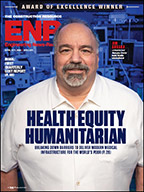...the endless legwork in the lab and in the offices of infrastructure stewards. The test took the work of many individuals who saw the potential of the HCB and fought for it.
The first was a $320,000 grant in 2000 from the Transportation Research Board’s Innovations Deserving Exploratory Analysis (IDEA) program, which helped jump-start the HCB process. “The HCB concept represents not just an incremental improvement to current bridge technology, but a genuine breakthrough,” says Chuck Taylor, IDEA program manager for high-speed rail.
John Unsworth, chief engineer of Canadian Pacific Railway, and Steve Millsap, chief engineer for Burlington Northern Santa Fe Railway, convinced several Class I railroads, members of the Association of American Railroads (AAR), to chip in $125,000. “We thought that it was necessary to support this new technology—the same way our forefathers did when they moved from wrought iron to steel bridge design and construction after 1875,” says Unsworth.
Adds Duane Otter, principal engineer at AAR’s Transportation Technology Center Inc., Pueblo, “John had done his homework—not just in telling the story of the HCB concept, but in asking and learning from prominent engineers, fabricators, constructors, academics, researchers, and owners.” AAR is now considering a permanent installation. The plan is to conduct accelerated service testing on the test span for a year or so and then move it to a revenue service installation for long-term monitoring.
Hillman also received moral and practical support from his colleagues at Teng & Associates and two universities. The IDEA grant was in Teng’s name. Teng hired as a subcontractor the University of Delaware, where the prototype span was spawned. The $90,000 first phase produced a “nasty-looking” beam and a process “not remotely close to being economically viable,” says Hillman. But it was encouraging enough to spur the second, $230,000 phase.
Refining the fabrication process took weekends and nights. Hillman and Zicko still refer to their company informally as the “Late Night Bridge Co.” With Nick Shevchenko, research associate at the university’s Center for Composites Materials, they tinkered with the resins, the concrete pours, the foam, the positions of the flanges, the openings. One frustrating night, they gave up trying to figure out why the vacuum process wasn’t working well. The next day, they found a pair of scissors inside the 8-ft-long beam.
When the beams were ready for the test run in Pueblo, Hillman was still waiting on the additional funding from AAR. Since the university contract had ended, there was no place to store them.
“They were the wayward orphans of the bridge world,” says Hillman. But Zicko’s then-employer, Coastal Precast Systems, Chesapeake, Va., came to the rescue, providing a temporary home until the Pueblo test became a reality.
Another key supporter is Harbor Technologies LLC, Brunswick, Maine, a composites manufacturer of marine...















